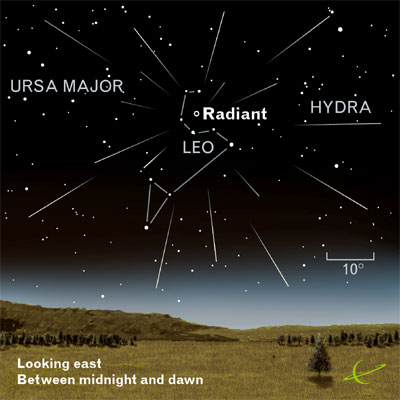|
Leonid Meteor Shower
Nov 18, 2001
The Leonid Meteor Shower will be at or near its peak early Sunday morning. The peak of the shower should be around 5-7 AM EST Sunday morning. This year we
could have a meteor storm rather than a shower with predictions of 700-2500 meteors per hour. The period of peak activity can be short, so set your alarm.
Face east and look up about 40-60 degrees (with your hand made
into a fist and at arms length away, 50 degrees is about five "fists" above the horizon).
Look in the constellation Leo. The Lion's head looks like a backward question mark (see the diagram below)
To photograph the meteors, you need a camera with a bulb setting, spare batteries, a fast (f/2, f/2.8 or f/4) normal to wide angle lens and fast film like Kodak
E200 or Kodak Elite Chrome 200 slide film.
Put a new roll of 200 speed slide film in your camera and set the film speed for 640. If using 100 speed slide film, set your camera for 320.
When you get your film processed, ask for "PUSH 2" processing.
If you use negative film, use Kodak or Fuji 800 speed film and set your camera film speed at 400. Ask for normal processing.
Since you are
at the beginning of a roll, take a normal picture inside before going out to do meteor pictures. This will help the person that mounts your film after it is processed.
Put on a 50 mm, 28 mm, 24 mm or wider lens on your
camera and set the aperture to f/2.8 (f4 for zoom lenses) and focus the lens on infinity (turn off autofocus). Put the camera on a tripod (or bean bag), and point it towards the east and aimed high in the sky. Put
the camera on bulb, and lock the shutter open for anywhere from 15 seconds to 15 minutes and wait. If you are lucky, one or more
meteors will streak through your field of view. Take lots of photos. Have spare batteries keeping warm in your pocket. Switch when your "in camera" batteries get tired or cold. Warm them up in your pocket for another switch.
A wider angle lens means you have more chance of catching meteors, but its light trail will be shorter. Even if you don't catch a meteor, you should get some interesting star trails with the longer exposures.
With short exposures the stars should be points rather than trails.
It is best if there are dark skys (no city lights) to the south of your location.
If it is cold outside, put your camera and lens in a zip lock
bag or back in your camera bag before bringing it back inside. You don't want moisture to condense inside of your equipment and turn things to rust.
Dress warm!!
|


